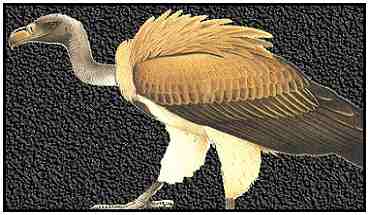Long-Billed GriffonOrder: Falconiformes. Family: Accipitridae. (Old World vulture). Scientific Name: Gyps indicus. Common Names: Long-billed Griffon or Indian Griffon. Conservation Status: Threatened. A rapid decline in bird numbers has been observed in India over the past three years. As an example, recent visits to what was previously considered one finest vulture areas in Hapur have shown the birds, which only two years ago numbered in their thousands here, are down to about a dozen. The reasons for this remain largely unknown, but options include a severe virus, the increasing use of pesticides, deliberate poisoning of carcasses, an increasing trend towards burying corpses rather than leaving them lying, calcium deficiency in chicks, or even the possibility of interference from an increase in tourism. At this stage, investigations mainly surround the possibility of a virus. Autopsies have been carried out on two birds and the liver and other organs were covered with whitish crystals assumed to be uric acid. The Long-billed Griffon and the Asian White-backed Vulture have both been affected severely by this problem with the birds declining by up to 95% in parts of their range. In only three years these vultures have gone from holding a status of common to being considered critically endangered, with extinction inevitable unless the source of this problem can be ascertained and halted urgently.
Long-Billed GriffonRescue & Recovery: It is hoped that between European and North American zoos enough birds can be located to provide a successful captive breeding population. Geographical Range: India and southeast Asia. Habitat: A northern race inhabit the Himalayan foothills and other mountainous areas, while a southern race occupies the plains of India and Southeast Asia. Physical Characteristics: The Long-billed Griffon is more sociable than most vultures. It has a long slender neck and bill ideally suited to reaching inside carcasses. Food: Carrion feeder. Reproduction: Nests in small numbers on inaccessible cliffs. |

